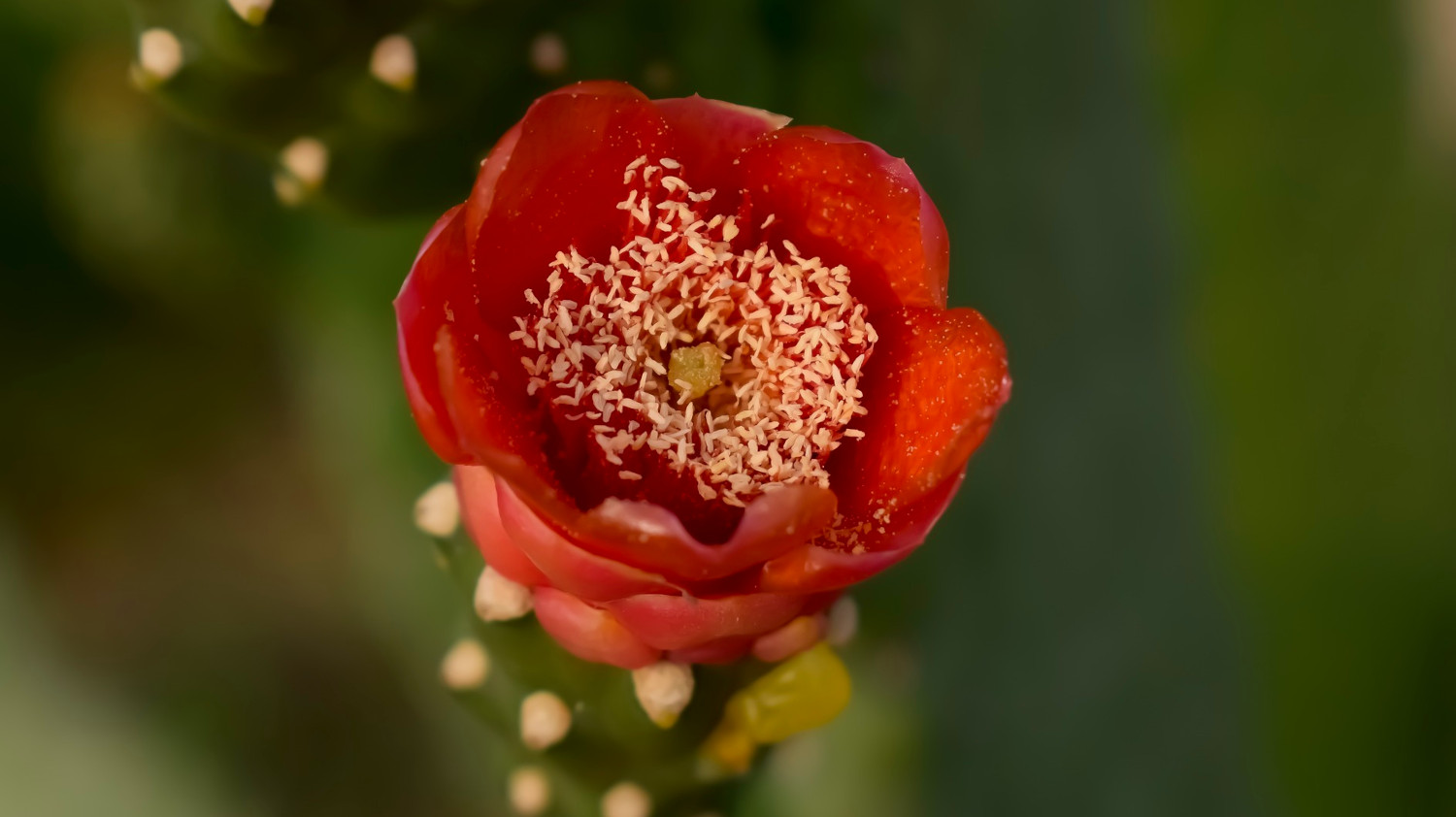Cactus with Red Flowers
Cacti with red flowers are a captivating sight and make a great addition to your plant collection. Their vibrant blooms add a pop of color to both outdoor landscapes and indoor gardens. In this article, let’s explore some popular cacti with red flowers and the ideal growing conditions for caring for these types of cacti.

Popular Cacti Species with Red Blooms
Cacti enthusiasts, especially those new to gardening, are in for a treat with these beginner-friendly red-flowered varieties. Each plant not only boasts stunning red blooms but also comes with easy-to-care-for characteristics, making them ideal choices for those starting their cactus collection.
1. Red-Flower Prickly Pear Cactus (Opuntia elatior)
The red-flower prickly pear cactus, native to parts of South America and Central America, has flat, paddle-like pads adorned white spines. Along the edges of these pads, large reddish flowers bloom, typically in spring to early summer. It’s important not to over-fertilize this cactus, as it may inhibit flowering.

This cactus is ideal for beginners in diverse climates, as it thrives as long as it is provided with ample direct sunlight and well-draining soil. Propagation can be done by breaking off a pad, but handle them with caution, using tongs or wearing thick gloves to avoid contact with the sharp glochids.
2. Christmas Cactus (Schlumbergera x buckleyi)
A popular holiday plant, the Christmas cactus, has segmented stems and boasts elegant red flowers that bloom during the festive season in late fall to early winter, making it a perfect seasonal decoration. This cactus is an ideal option for an indoor plant as it lacks spines and is non-toxic to pets and humans.

To encourage blooming, mimic the natural habitat of a Christmas cactus by providing the plant with 12-14 hours of darkness for a maximum of 10 days, either by leaving it in a dark room or covering it with cloth. Exposure to cooler temperatures during the fall may also stimulate blooming. Avoid feeding the plant fertilizer during its bloom cycle.
Christmas cactus not blooming? Possible reasons why a Christmas cactus isn’t blooming flowers may include insufficient darkness provided or the temperature being too warm or fluctuating too much, both of which can stress the plant.

Place this cactus in bright, indirect light and provide well-draining soil. Water the plant thoroughly and keep the soil consistently moist, especially during its growing season. Reduce watering frequency during the dormancy period in winter. Propagation is possible through stem cuttings, using clean, sharp scissors or pruning shears.
3. Fire Barrel Cactus (Ferocactus gracilis)
The fire barrel cactus, native to Mexico, has a barrel-shaped body with spines growing from its surface and produces showy red flowers in a crown-like fashion. This plant typically blooms in the summer.

Ideal for arid and desert landscapes, this cactus requires full sunlight exposure. It has low maintenance water needs, requiring watering only during weather conditions with extreme drought. Water sparingly, allowing the soil to dry out between waterings, and keep the soil dry during its dormant winter period. This cactus can thrive even without fertilizer.
4. Claret Cup Cactus (Echinocereus triglochidiatus)
The claret cup cactus, native to Southwest America and Mexico, produces stunning red and orange flowers, typically in spring to early summer, attracting pollinators like bees.

Perfect for beginners, it’s one of the easiest cacti to bloom, as long as you provide it plenty of direct sunlight and use a well-draining, rocky soil mix. Ensure the soil stays dry during its dormant winter period.
5. Fishhook Cactus (Mammillaria)
The fishhook cactus is a small, globe-shaped cactus with hooked spines. In the early summer, this plant showcases striking red flowers almost the same size as the cactus body.

It’s an excellent choice for both indoor and outdoor gardens due to its compact size and low-maintenance water requirements. Use well-draining soil and water sparingly, allowing the soil to dry out between waterings. Provide this cactus with bright, indirect sunlight and a warm, arid environment.
6. (Grafted) Moon Cactus (Gymnocalycium mihanovichii)
The moon cactus, also known as the ruby ball cactus, is an unusual and eye-catching species which consists of a globe-shaped vibrant top part grafted onto a tall, columnar cactus rootstock. It may produce red flowers in late spring to early summer.
These little guys have seem to become really popular at home centers. Every time I stroll through any of these corporate garden centers there are an over abundance of these grafted little plants.

This cactus is a popular choice for indoor gardeners with limited space. It requires bright, indirect light, so use blinds to shield your moon cactus from harsh direct sunlight. Ensure it has a well-draining soil mix and water sparingly. During its dormant period in the winter, avoid watering, and consider repotting it into nutrient-rich soil in the following spring.

Enhancing Your Space with Red-Flowering Cacti
These varieties of cacti not only bring vibrant colors to your garden but also offer a forgiving and enjoyable experience for those taking their first steps into the world of cactus growing! By understanding their unique growing conditions and following proper care guidelines, you can cultivate these remarkable plants successfully. Their vibrant red flowers will undoubtedly bring beauty and joy to your garden or indoor space.

